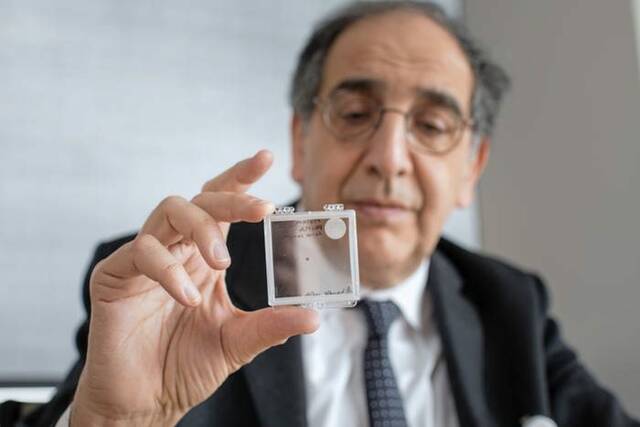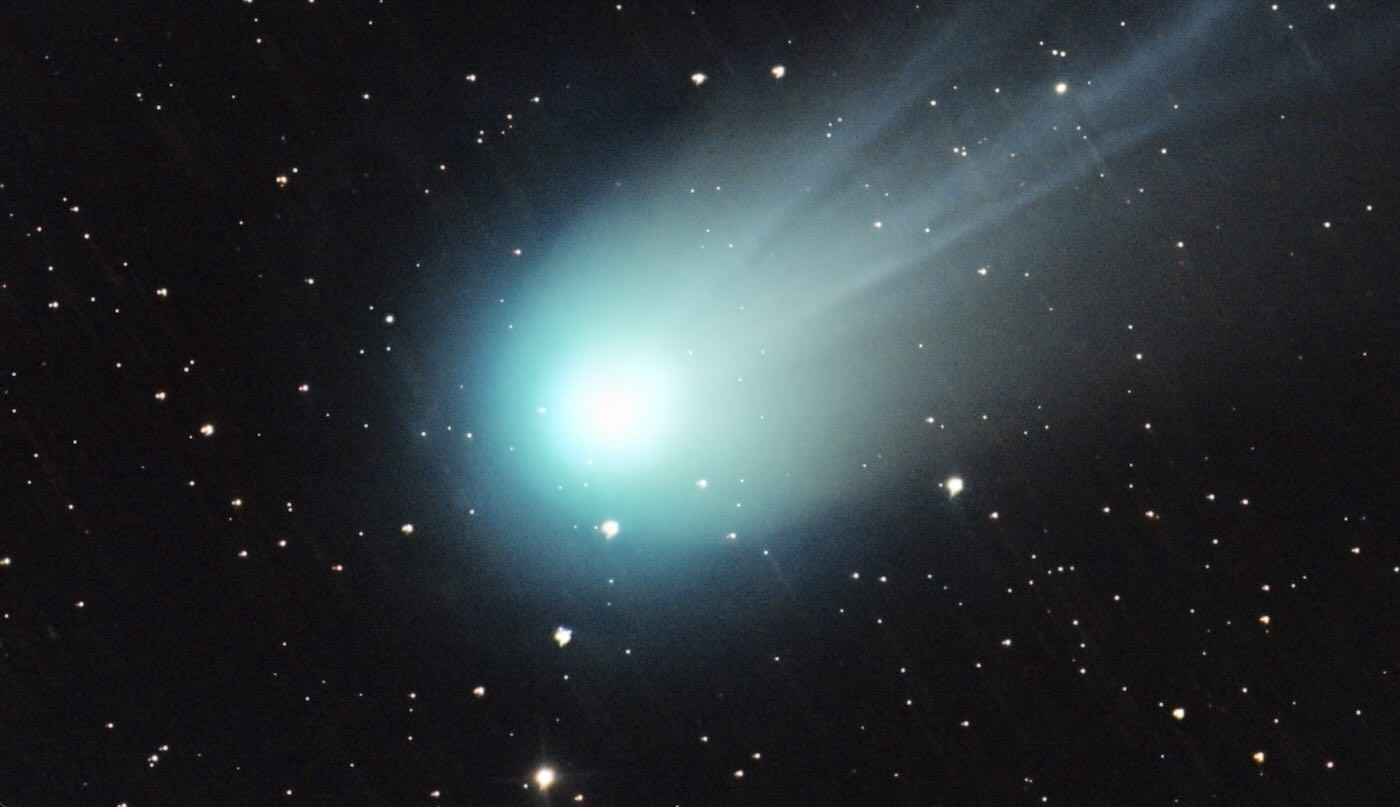Welcome to this edition of The Intelligence Brief… This week, astronomers in China have detected a series of unusual radio signals from comet 12P/Pons-Brooks, one of the brightest and most active comets in the solar system. In our analysis, we’ll examine 1) how multi-band radio observations using the Tianma Radio Telescope revealed the most distant detection of ammonia molecules ever observed in a comet, 2) why these findings may explain the comet’s mysterious outbursts as it approaches the Sun, 3) what the results reveal about volatile ices preserved since the solar system’s formation 4.6 billion years ago, and 4) how these insights could inform future radio studies of interstellar visitors like 3I/ATLAS, offering new clues about the chemistry—and potential technological mysteries—of comets crossing our cosmic neighborhood.
Quote of the Week
“Comets like this are frozen relics left over from the birth of our solar system 4.5 billion years ago.”
– M.A. Cordiner, NASA Goddard
If you enjoy the news and perspectives offered by The Debrief, make sure that you aren’t missing our stories by making us one of your “preferred sources” on Google News. You can simply follow this link to add The Debrief to your list of favorites, and you can read more about Google’s preferred sources in our recent article here.
RECENT NEWS from The Debrief
Radio Signals from a Comet?
Evidently, it’s a big week for news involving comets, as a team of astronomers now reports the detection of an intriguing series of radio signals emanating from one of the speeding objects (no, not that comet) currently making its way through our solar system.
The surprising news comes to us courtesy of a research team led by the Shanghai Astronomical Observatory of the Chinese Academy of Sciences, and was reportedly made possible with the Tianma Radio Telescope.
During multi-band radio observations of comet 12P/Pons-Brooks, the team detected an interesting series of radio signals coming from the returning comet, which is also one of the brightest comets astronomers have ever seen.
At a glance, this all sounds pretty tantalizing… but what does the detection of radio signals from a comet in our solar system actually mean?
A Returning Comet Stops In
First discovered in 1812, 12P/Pons-Brooks possesses an orbital period of around 71 years, meaning that this is actually the fourth time astronomers have had an opportunity to watch it during its journeys through the solar system.
During their recent observations of the Halley-type comet, the Chinese team says they measured the rate at which water was being produced by 12P/Pons-Brooks, which revealed the most distant known detection of ammonia molecules known to astronomers from such observations.
Since comets are known to contain a variety of icy components—many of which are as old as the solar system itself—they are ideal for observations by astronomers, particularly when these materials begin to bake off as the speeding objects make their way toward the Sun.
In the case of comets like 12P/Pons-Brooks, the presence of volatile ices shows that they haven’t been subjected to large amounts of thermal evolution since they were born in our solar system eons ago. Because of this, the study of the ices they carry and their composition offers a way for astronomers to look back in time at the chemical and thermal conditions that were present in our planetary neighborhood around 4.6 billion years ago.
Mysterious “Outbursts” and Radio Signals
Intriguingly, the comet is known to have produced unusual “outbursts” during each of its visits, the exact cause of which currently remains unknown to astronomers.
Last year, when the object made its most recent approach, several similar short “bursts” in its brightness were detected, which astronomers believe are probably linked to the release of gases as the object is warmed by the Sun.
Between late 2023 and 2024, L-band and K-band radio observations of 12P/Pons-Brooks made with the Tianma Telescope revealed L-band detections of an 18-cm hydroxyl (OH) spectral line, which, in simple terms, reveals evidence of water vapor. Based on this detection, the Chinese researchers were able to calculate the rates at which water was being produced and at which gas expansion occurred, in relation to the onset and conclusion of the comet’s latest series of outburst events.
These observations revealed that at distances from the Sun of about 1 astronomical unit (AU), 12P/Pons-Brooks releases up to around 5 tons of water vapor each second, revealing activity levels far greater than most short-period comets, as well as a few of those exhibiting longer periods. Additionally, ammonia molecules were revealed during K-band observations, which represent the most distant radio-wave detections of the compound in a comet to date.
In short, the high abundance of ammonia detected by the team’s observations suggests a significant enough distribution throughout the comet’s nucleus to explain 12P/Pons-Brooks’s frequent outbursts, in addition to providing new insights into how the composition of comets can influence their activity.
So What About Possible Signals From That “Other” Comet?
Of course, the comet that’s been getting all the attention in the astronomical community lately has been one of 12P/Pons-Brooks’s long-distance cousins: the interstellar object 3I/ATLAS. However, considering the intriguing discoveries made during the recent surveys of 12P/Pons-Brooks it raises the question of what kinds of unique things radio astronomy might reveal about an interstellar comet.
Ideally, the Chinese team’s recent study suggests that similar observations might offer intriguing insights into some of the dynamics behind a few of 3I/ATLAS’s more intriguing characteristics, such as its Sun-facing “anti-tail” and other unusual features.
Additionally, considering the very remote possibility that 3I/ATLAS might display signs of technology—a controversial idea that has failed to receive widespread acceptance among most astronomers—radio astronomy could indeed offer another means of potentially determining whether it, or other interstellar visitors like it in the future, may show any signs of technology.
For now, while the evidence continues to point to natural explanations for the unusual features detected during recent observations of comets like 12P/Pons-Brooks and 3I/ATLAS, all underscore the exciting opportunities astronomers have for learning new things about these space objects, their compositions, and their ancient origins.
That concludes this week’s installment of The Intelligence Brief. You can read past editions of our newsletter at our website, or if you found this installment online, don’t forget to subscribe and get future email editions from us here. Also, if you have a tip or other information you’d like to send along directly to me, you can email me at micah [@] thedebrief [dot] org, or reach me on X: @MicahHanks.

- Physicists Change the Nature of Matter With Light in Breakthrough That Blurs the Line Between Science and Magic
Scientists use light to change matter’s magnetic nature at room temperature, revealing quantum effects once thought impossible.
- Levitation Breakthrough Enables Scientists to Sort Living Cells Using “Invisible Force” Instead of Physical Contact
A groundbreaking new device uses electromagnetic levitation to help researchers gently sort living cells, with no need for physical contact.
- Astronomers Just Spotted an Undiscovered Space Object Hiding in the Sun’s Glare—And It’s Moving Extremely Fast
Hidden by the Sun’s glare, a new space object has been found lurking in our Solar System, and it’s one of the fastest-moving of its kind.
- Unexpected Earth-Sized Exoplanets Discovered in Binary Star System “Test the Limits of Planet Formation Models”
A trio of newly discovered exoplanets is defying the expectation that binary systems are hostile to planet formation, according to an international team of researchers.
- Ancient Mayan Astronomers Perfected a 700-Year System for Eclipse Prediction, New Study Reveals
New research reveals how Mayan astronomers built a precise eclipse prediction system using complex lunar mathematics.
- Scientists Are Putting $14.2M Behind an Ambitious New Effort to Map the Body’s “Hidden” Sixth Sense
NIH invests $14.2 million to map interoception, the body’s hidden sixth sense, revealing how the brain monitors vital internal signals.
- Are 4K and 8K Televisions Worth it? Scientists Say These Experiments May Finally Settle the Debate
Recent experiments reveal the right display size and sitting distance required for people to differentiate between 4K, 8K, and HD TVs.
- Physicists Revive a 19th-Century Theory of “Cosmic Knots” to Help Untangle the Mysteries of Dark Matter and Neutrinos
A long-dismissed theory involving “cosmic knots” could help explain the origins of neutrino masses, dark matter, and other mysteries.
- Elusive ‘Alfvén Waves’ Have Been Discovered in the Sun’s Corona, Ending Nearly a Century of Searching
Scientists have finally discovered theoretical torsional Alfvén waves within the Sun’s corona, concluding a decades-long search.
- Scientists Demonstrate ‘Brain-Inspired’ Computers Made from Mushrooms That Mimic Neural Activity
Scientists have designed a novel fungus-based computer system that incorporates parts made from common shitake mushrooms.
- Do NFL Refs Favor the Kansas City Chiefs? New Research Says Yes: The Data Backs Fans’ Suspicions
A new study suggests that NFL referees may favor the Chiefs in key games, potentially linking postseason calls to league profits and financial pressure.
- “Nowhere Else Could We Have Achieved This”: This Physics Experiment Aboard the ISS Could Significantly Improve Spacecraft Safety
European researchers aboard the ISS are investigating the fundamental nature of condensation to mitigate hazards to spacecraft electronics.
- “This Marks a Paradigm Shift”: Study Finds ‘Technological Fingerprint’ Proving First Americans Arrived Over 20,000 Years Ago
New analysis of ancient artifacts reveal evidence that the First Americans arrived from East Asia by traveling along the coast more than 20,000 years ago.
- Ancient DNA Reveals the Secret Killers That Wiped Out Napoleon’s Army in 1812
Ancient DNA reveals Napoleon’s army was decimated by hidden fevers, not typhus, during the disastrous 1812 Russian invasion.
- Striking New Fossils From a Dinosaur “Mummy Zone” Helped Solve a Mystery More Than a Century in the Making
The preserved record of “dinosaur mummies” soft tissue discovered in Wyoming is shedding new light on what these creatures truly looked like.
- Can You Trust Your Weed Dealer? New Study Finds Nearly Half of Cannabis Labels Overstate THC Potency
Colorado study reveals nearly half of Cannabis flower products exaggerate THC levels, raising concerns over labeling accuracy.
- New Study Warns Planet-Cooling Stratospheric Aerosol Injections are Unpredictable, Risky, Could End in Disaster
New study reveals stratospheric aerosol injections may be far riskier than expected, with major technical and governance limits.
- Warning Network’s Campaign to ‘Target’ 3I/ATLAS Sparks Theories About Secret Planetary Defense Effort
This week, the International Asteroid Warning Network (IAWN) announced a new campaign that will target 3I/ATLAS.
- “We Made an Exciting Discovery”: Astronomers Spot ‘Super Earth’ in Star’s Habitable Zone Less Than 20 Light Years From Earth
A newly spotted ‘super-Earth’ orbiting within its star’s habitable zone, just 20 light-years from Earth, could host extraterrestrial life.
- The Discovery of a New Type of Time Crystal is Challenging Past Thinking on These Unusual Structures
Researchers have discovered that quantum interactions between particles can be used to create time crystals with their own internal rhythm, challenging previous beliefs about these strange structures.
- Power From Water: Scientists Use H20, Precision Engineering, and Friction to Generate Electricity
Scientists have invented a new type of device that uses water and silicon covered with tiny pores to convert friction into usable electricity.
First Appeared on
Source link












